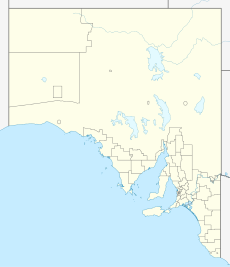Hundred of Noarlunga
|
Hundred of Noarlunga South Australia |
|||||||||||||||
|---|---|---|---|---|---|---|---|---|---|---|---|---|---|---|---|

Hallett Cove is halfway along the hundred coastline.
|
|||||||||||||||
| Coordinates | 35°04′41″S 138°37′52″E / 35.078°S 138.631°ECoordinates: 35°04′41″S 138°37′52″E / 35.078°S 138.631°E | ||||||||||||||
| Established | 1846 | ||||||||||||||
| Area | 120 km2 (46.3 sq mi) | ||||||||||||||
| County | Adelaide | ||||||||||||||
|
|||||||||||||||
The Hundred of Noarlunga is a cadastral unit of hundred in South Australia covering the far south-western Adelaide metropolitan area south and west of the Sturt River and north and west of the Onkaparinga River. It is one of the eleven hundreds of the County of Adelaide stretching from Glenelg in the northwest to Port Noarlunga in the southwest; and spanning inland between the Sturt and Onkaparinga to Bridgewater in the Adelaide foothills. It was named in 1846 by Governor Frederick Robe, Noarlunga being likely derived from 'nurlongga', an indigenous word referring to the curvature in the Onkaparinga River at Old Noarlunga, dubbed Horseshoe Bend by European settlers.
Contemporary Australian linguists believe the name 'Noarlunga' is derived from the Kaurna nurlo (corner/curve/bend) + ngga (place). Early South Australian Christian missionaries, Christian Teichelmann and Clamor Schürmann, recorded this meaning of the word in 1840, among about 2000 translations of local indigenous words.
The Australasian Biospecimen Network Association (ABNA) records Noarlunga as meaning "fishing place", as suggested by various early South Australian historians and repeated by some official sources, such as the City of Onkaparinga and the state government land titles office. However, from the 2010s, expert opinion has favoured the "curve" translation.
In the north of the hundred, the District Council of Brighton (later called the City of Marion) was established at Brighton and Marion in 1853. The Town of Glenelg municipality was established at Glenelg in 1855, closely followed by the Town of Brighton (by secession from the district council) in 1858. In 1886 the district council changed its name to District Council of Marion to avoid confusion with the Town of Brighton. The two seaside township councils governed the northern coastal tip of the hundred until 1997 when they merged to form the City of Holdfast Bay. Beside them, Marion council gained city status in 1940s as the Adelaide metropolis extended southwards and urbanisation took hold throughout the entire council area.
...
Wikipedia

